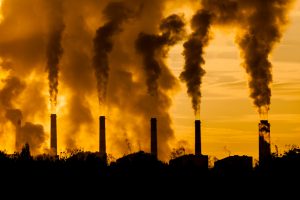Countries need to act faster to reduce greenhouse gas emissions or risk missing 2030 climate targets according to the 9th Emissions Gap Report, published by the United Nations Environment Programme.
The report highlights the gulf between climate targets and what is needed to avoid the worst effects of global warming. The “climate gap” is the difference between the emissions cuts required to meet climate targets, and the cuts expected based on existing national commitments, known as nationally determined contributions (NDCs). The report says that meeting the Paris Agreement target of limiting the global average temperature rise to 2C will require NDCs to to be three times higher – and five times higher to hit a 1.5C target.
Next week, governments will meet for annual climate talks in Poland where they will discuss mechanisms to close the gap.
Global emissions up again
After three years of stability, global carbon emissions actually increased in 2017. According to the report, emissions were flat between 2014-2016, but then rose in 2017 by 1.1% (not including changes in land use).
The three years of stable emissions had been seen as a positive sign that emissions had been uncoupled from economic growth and that a carbon peak was no longer a distant prospect.
The report makes clear that carbon emissions have not peaked. It says: “The 2017 increase leaves considerable uncertainty as to whether the 2014-2016 slowdown was driven primarily by short-term economic factors.”
According to the report, if warming is to be limited to 2C at the lowest possible cost, carbon emissions must drop 25% on current levels by 2030. For the 1.5C target, a 55% reduction is necessary.
China’s commitment
China is the world’s largest carbon emitter, accounting for about one quarter of global emissions, so the timing of its peak is crucial to closing the emissions gap.
In 2014, China said for the first time that it would aim to peak its emissions in 2030 or thereabouts, and strive to do so earlier. At that point the country’s coal consumption – its main source of primary energy – showed signs of having peaked, with coal consumption and economic growth gradually decoupling. However, the fall in coal consumption ended last year with a rise of 0.4%.
Peak uncertainty
A recent paper in Nature Geoscience by professor Guan Dabo and Meng Jing of the University of East Anglia argues that China is going through a period of minor fluctuations in its carbon emissions. According to the researchers, the country’s slower economic growth in recent years has helped reduce emissions, but more important are efforts to restructure industry and reduce coal in the energy mix.
Most Chinese experts think China hasn’t yet seen a peak, but that it will happen between 2020 and 2025. The decline in emissions growth and small fluctuations seem like “pre-peak” phenomena.
Jiang Kejuan, a researcher with the National Development and Reform Commission’s Energy Research Institute, thinks that China’s carbon emissions from the energy sector will peak before 2025, and possibly as early as 2020-2022. Jiang’s team have modelled China’s emissions and found that energy-hungry industries are very likely to peak by 2020, and that this will subsequently lead to significantly slower growth in energy demand. Taking into account the development of renewables, nuclear and natural gas, as well as technological advances, Jiang sees a strong possibility for China’s carbon emissions to peak between 2020 and 2023.
However, researchers from the Lawrence Berkeley National Laboratory published a paper, Near-term trends in China's coal consumption, which finds that emerging “lower energy-intensive and higher electricity-intensive sectors” will result in huge demand for electricity that non-coal sources of power will not be able to satisfy. These include light industry, commercial offices and residences. The coal saved by lowered demand from energy-intensive industry will be needed to provide that electricity. According to the research team, China’s coal consumption has not peaked and will continue to increase until 2020 at least.
Watching 2018
Coal consumption and carbon emissions both rebounded in the first three quarters of 2018, seemingly confirming the viewpoint of the Lawrence Berkeley researchers. Increased coal consumption came primarily from the power, steel, construction and chemicals sectors, while consumption from the power sector outstripped predictions. China’s total electricity consumption rose 8.9% year-on-year in the first nine months of 2018, two percentage points more than the previous year and the highest growth figure for six years. Much of that increase was from the service sector and residential buildings.
But Guan Dabo says: “In the near-term, China’s carbon emissions will fluctuate.” He adds that the increases in 2017 and 2018 reflect the normal operations of the Chinese economy, and that 2018’s emissions figures will be roughly similar to those for 2013.
Jiang Kejuan says that “China’s economic structure is changing and forces driving carbon emissions are nowhere enough for a rebound.” He adds that industrial restructuring and the continuing development of renewables will continue to reduce energy intensity – and these factors will help China peak its emissions sooner rather than later.









